1994 OLDSMOBILE SILHOUETTE instrument panel
[x] Cancel search: instrument panelPage 109 of 276
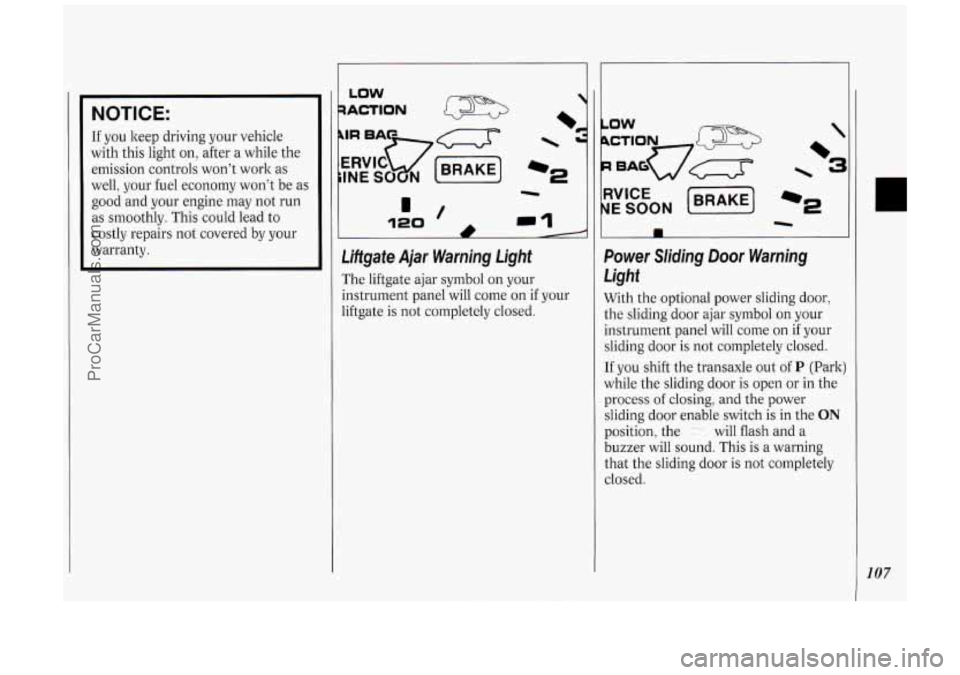
NOTICE:
If you keep driving your vehicle
with this light on, after a while the
emission controls won't work as
well, your fuel economy won't be as
good and your engine may not run
as smoothly.
This could lead to
costly repairs not covered by your
warranty.
Liifgate Ajar Warning Light
The liftgate ajar symbol on your
instrument panel will come on if your
liftgate is not completely closed.
Power Sliding Door Warning
Light
With the optional power sliding door,
the sliding door ajar symbol on your
instrument panel will come on if your
sliding door is not completely closed.
If you shift the transaxle out
of P (Park)
while the sliding door is open or in the
process
of closing, and the power
sliding door enable switch is in the
ON
position, the - will flash and a
buzzer will sound. This is a warning
that the sliding door is not completely
closed.
107
ProCarManuals.com
Page 114 of 276
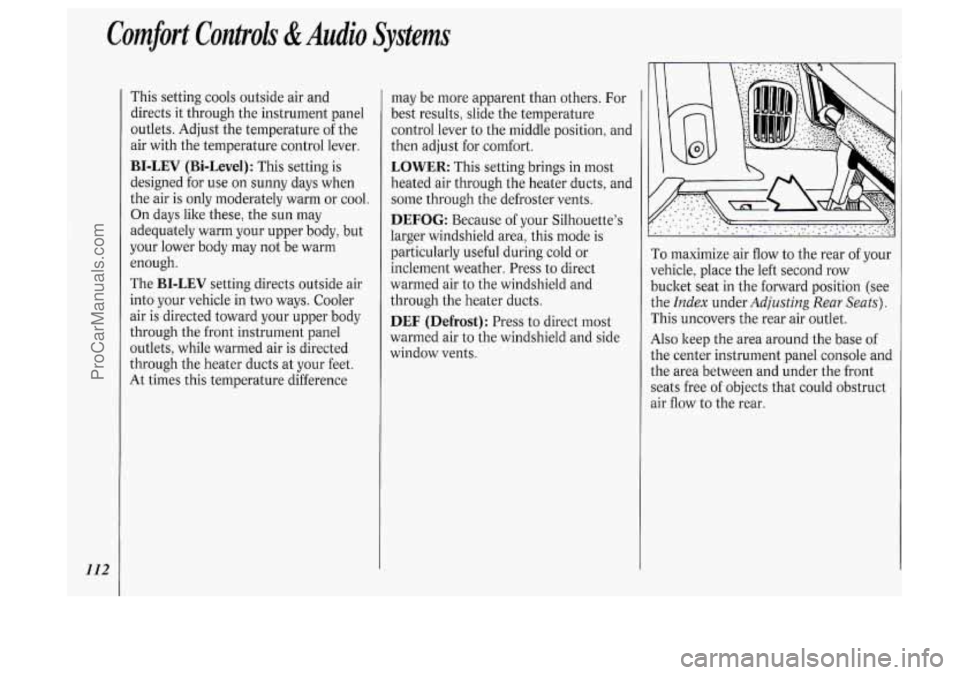
Comfort Controh &Audio Systems
112
This setting cools outside air and
directs it through the instrument panel
outlets. Adjust the temperature of the
air with the temperature control lever.
BI-LEV (Bi-Level): This setting is
designed for use
on sunny days when
the air is only moderately warm or cool.
On days like these, the
sun may
adequately warm your upper body, but
your lower body may not be warm
enough.
The
BI-LEV setting directs outside air
into your vehicle in two ways. Cooler
air is directed toward your upper body
through the front instrument panel
outlets, while warmed air
is directed
through the heater ducts
at your feet.
At times this temperature difference may be
more apparent than others. For
best results, slide the temperature
control lever
to the middle position, and
then adjust for comfort.
LOWER: This setting brings in most
heated air through the heater ducts, and
some through the defroster vents.
DEFOG: Because of your Silhouette’s
larger windshield area, this mode is
particularly useful during cold or
inclement weather. Press to direct
warmed air to the windshield and
through the heater ducts.
DEF (Defrost): Press to direct most
warmed air to the windshield and side
window vents.
To maximize air flow to the rear of your
vehicle, place the left second row
bucket seat in the forward position (see
the
Index under Adjusting Rear Seats).
This uncovers the rear air outlet.
Also keep the area around the base of
the center instrument panel console and
the area between and under the front
seats free of objects that could obstruct
3ir flow to the rear.
ProCarManuals.com
Page 115 of 276
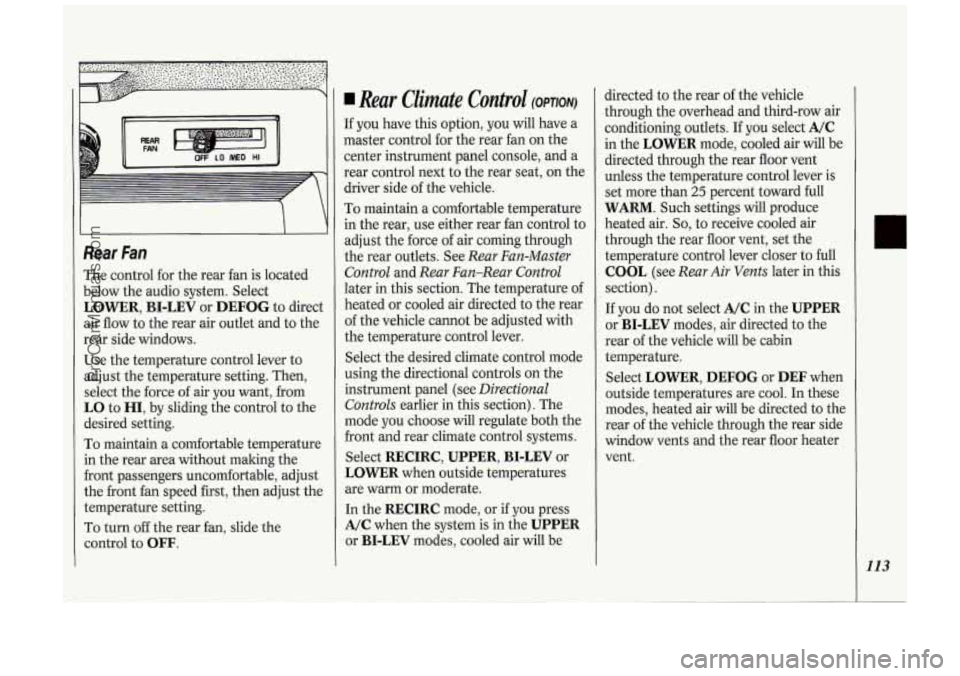
h d II
II I(
Rear Fan
The control for the rear fan is located
below the audio system. Select
LOWER, BI-LEV or DEFOG to direct
air flow to the rear air outlet and to the
rear side windows.
Use the temperature control lever to
adjust the temperature setting. Then,
select the force of air you want, from
LO to HI, by sliding the control to the
desired setting.
To maintain a comfortable temperature
in the rear area without making the
front passengers uncomfortable, adjust
the front fan speed first, then adjust the
temperature setting.
To turn off the rear fan, slide the
control to
OFF.
Rear Climate Control (OPTION)
If you have this option, you will have a
master control for the rear fan on the
center instrument panel console, and a
rear control next to the rear seat, on the
driver side of the vehicle.
To maintain a comfortable temperature
in the rear, use either rear fan control to
adjust the force
of air coming through
the rear outlets. See
Rear Fan-Master
Control
and Rear Fan-Rear Control
later in this section. The temperature of
heated or cooled air directed to the rear
of the vehicle cannot be adjusted with
the temperature control lever.
Select the desired climate control mode
using the directional controls on the
instrument panel (see
Directional
Controls
earlier in this section). The
mode you choose will regulate both the
front and rear climate control systems.
Select
RECIRC, UPPER, BI-LEV or
LOWER when outside temperatures
are warm or moderate.
In the
RECIRC mode, or if you press
A/C when the system is in the UPPER
or BI-LEV modes, cooled air will be directed
to the rear
of the vehicle
through the overhead and third-row air
conditioning outlets. If
you select A/C
in the LOWER mode, cooled air will be
directed through the rear floor vent
unless the temperature control lever is
set more than
25 percent toward full
WARM. Such settings will produce
heated air.
So, to receive cooled air
through the rear floor vent, set the
temperature control lever closer to full
COOL (see Rear Air Vents later in this
section).
If
you do not select A/C in the UPPER
or BI-LEV modes, air directed to the
rear of the vehicle will be cabin
temperature.
Select
LOWER, DEFOG or DEF when
outside temperatures are cool. In these
modes, heated air will be directed to the
rear of the vehicle through the rear side
window vents and the rear floor heater
vent.
113
ProCarManuals.com
Page 116 of 276
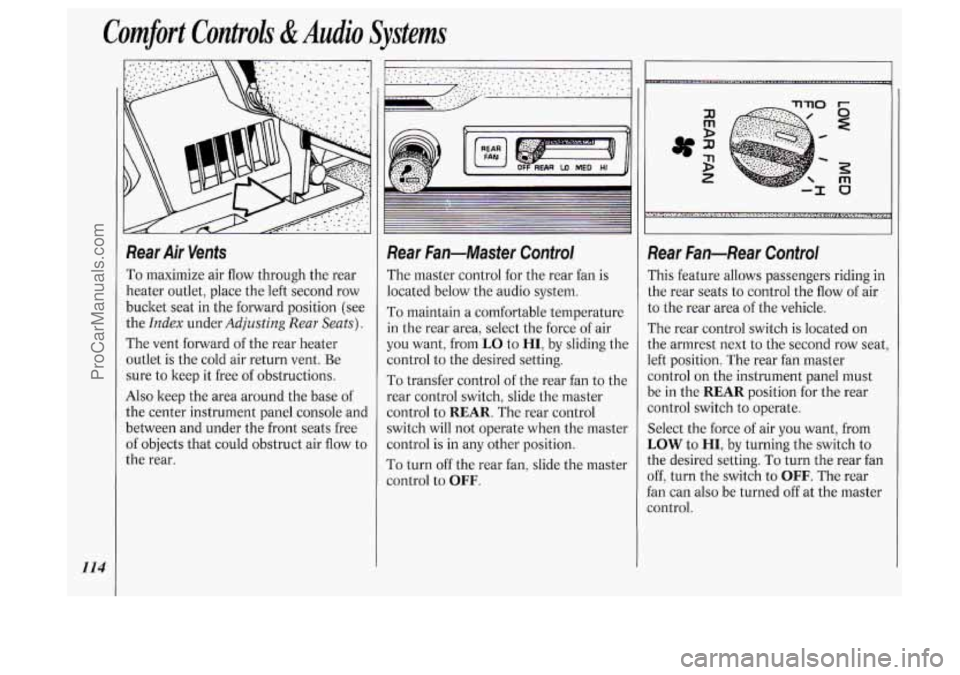
Comfort Controls &Audio Systems
114
Rear Air Vents
To maximize air flow through the rear
heater outlet, place the left second row
bucket seat in the forward position (see
the
Index under Adjusting Rear Seats).
The vent forward of the rear heater
outlet is the cold air return vent. Be
sure to keep it free of obstructions.
Also keep the area around the base
of
the center instrument panel console and
between and under the front seats free
of objects that could obstruct air flow to
the rear.
Rear Fan-Master Control
The master control for the rear fan is
located below the audio system.
To maintain a comfortable temperature
in the rear area, select the force of air
you want, from LO to HI, by sliding the
control to the desired setting.
To transfer control of the rear fan to the
rear control switch, slide the master
control to
REAR. The rear control
switch will not operate when the master
control is in any other position.
To turn off the rear fan, slide the master
control to
OFF.
Rear Fan-Rear Control
rhis feature allows passengers riding in
;he rear seats to control the flow of air
;o the rear area of the vehicle.
rhe rear control switch
is located on
:he armrest next to the second row seat,
eft position. The rear fan master
:ontrol on the instrument panel must
)e in the
REAR position for the rear
:ontrol switch to operate.
Select the force of air you want, from
LOW to HI, by turning the switch to
:he desired setting.
To turn the rear fan
Iff, turn the switch to OFF. The rear
an can also be turned off
at the master
:ontrol.
ProCarManuals.com
Page 117 of 276
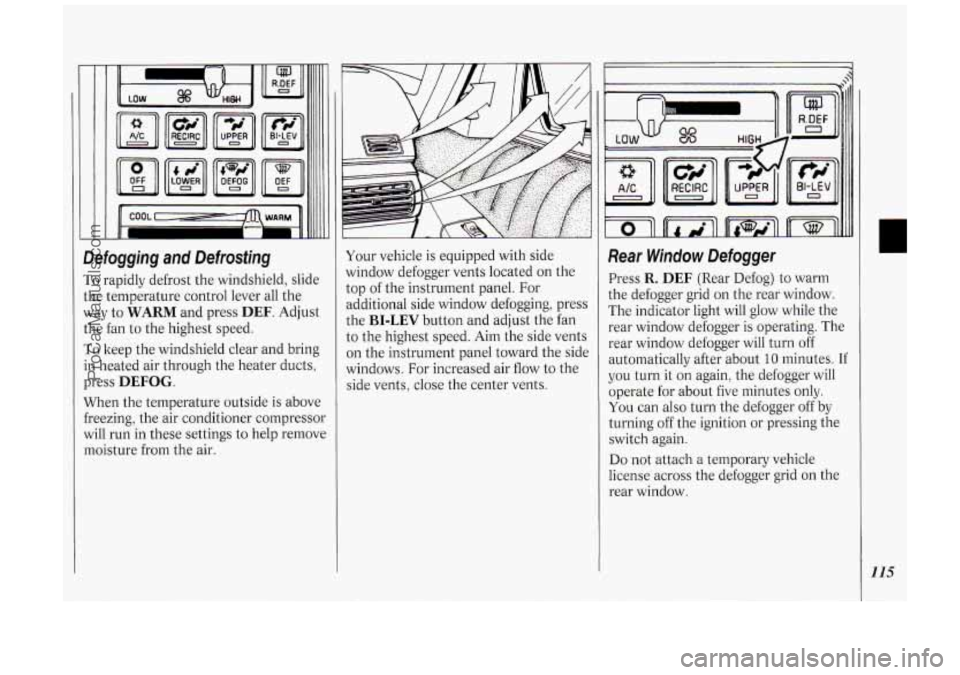
Defogging and Defrosting
To rapidly defrost the windshield, slide
the temperature control lever all the
way to
WARM and press DEF. Adjust
the fan to the highest speed.
To keep the windshield clear and bring
in heated air through the heater ducts,
press
DEFOG.
When the temperature outside is above
freezing, the air conditioner compressor
will run in these settings to help remove
moisture from the air. Your vehicle
is equipped with side
window defogger vents located on the
top of the instrument panel. For
additional side window defogging, press
the
BI-LEV button and adjust the fan
to the highest speed. Aim the side vents
on the instrument panel toward the side
windows. For increased air flow to the
side vents, close the center vents.
Rear Window Defogger
Press R. DEF (Rear Defog) to warm
the defogger grid on the rear window.
The indicator light will glow while the
rear window defogger is operating. The
rear window defogger will turn off
automatically after about
10 minutes. If
you turn it on again, the defogger will
operate for about five minutes only.
You can also turn the defogger off by
turning off the ignition or pressing the
switch again.
Do not attach a temporary vehicle
license across the defogger grid on the
rear window.
115
ProCarManuals.com
Page 118 of 276
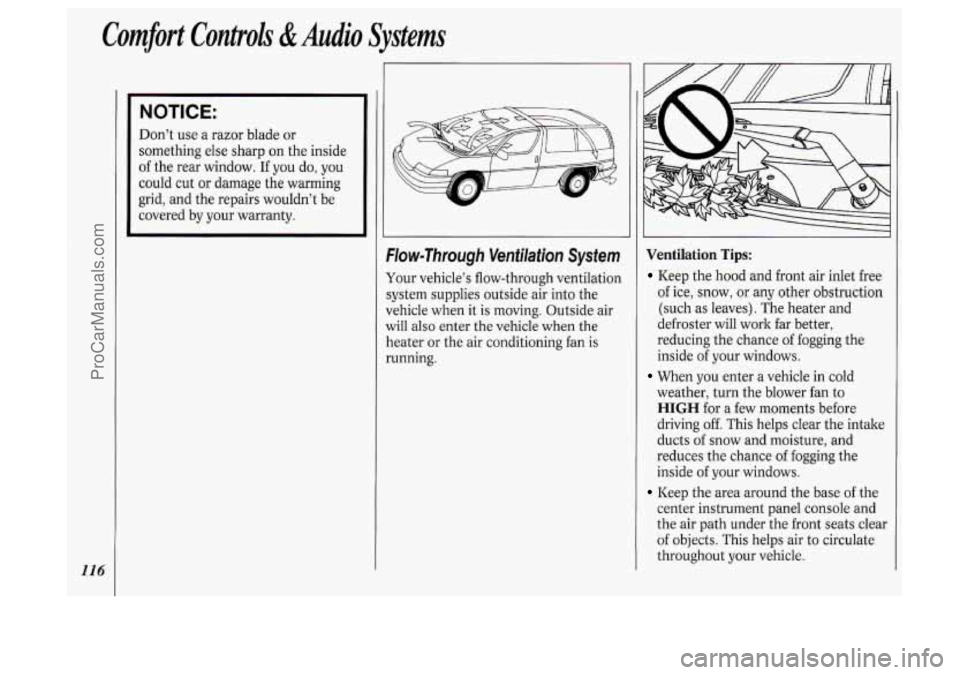
116
Comfort Controh di Audio Systems
NOTICE:
Don’t use a razor blade or
something else sharp on the inside
of the rear window. If you do, you
could cut or damage the warming
grid, and the repairs wouldn’t be
covered by your warranty.
elow-Through Ventilation System
four vehicle’s flow-through ventilation
;ystem supplies outside air into the
{ehicle when
it is moving. Outside air
will also enter the vehicle when the
leater or the air conditioning fan is
sunning.
I I
Ventilation Tips:
Keep the hood and front air inlet free
of ice, snow, or any other obstruction
(such as leaves). The heater and
defroster will work far better,
reducing the chance of fogging the
inside of your windows.
When you enter a vehicle in cold
weather, turn the blower fan to
HIGH for a few moments before
driving off. This helps clear the intake
ducts of snow and moisture, and
reduces the chance of fogging the
inside of your windows.
Keep the area around the base of the
center instrument panel console and
the air path under the front seats clear
of objects. This helps air to circulate
throughout your vehicle.
ProCarManuals.com
Page 138 of 276
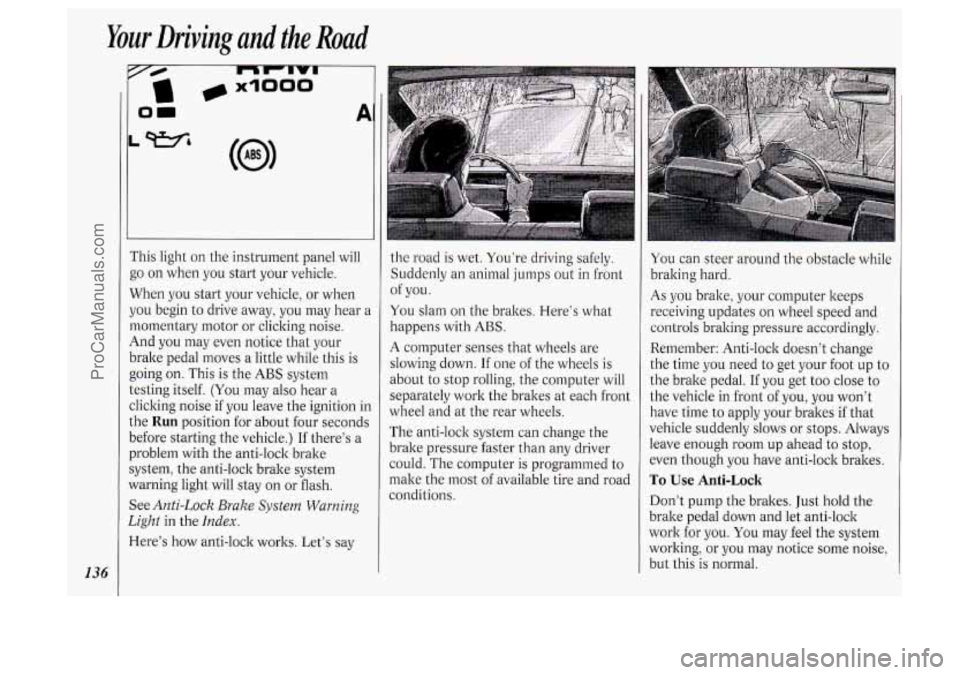
Your Driving and the Road
* x1000
136
i‘his light on the instrument panel will
go on when you start your vehicle.
When you start your vehicle, or when
jou begin to drive away, you may hear a
nomentary motor or clicking noise.
4nd you may even notice that your
)rake pedal moves
a little while this is
going on. This is the
ABS system
:esting itself.
(You may also hear a
:licking noise if you leave the ignition in
.he
Run position for about four seconds
Iefore starting the vehicle.) If there’s a
Jroblem with the anti-lock brake
iystem, the anti-lock brake system
Yarning light will stay on or flash.
See
Anti-Lock Brake System Warning
2ight
in the Index.
lere’s how anti-lock works. Let’s say
1
the road is wet. You’re driving safely.
Suddenly an animal jumps out
in front
You slam on the brakes. Here’s what
happens with
ABS.
A computer senses that wheels are
slowing down.
If one of the wheels is
about to stop rolling, the computer will
separately work the brakes at each front
wheel and at the rear wheels.
The anti-lock system can change the
brake pressure faster than any driver
could. The computer is programmed to
make the most of available tire and road
conditions. of
you.
You can steer around the obstacle while
braking hard.
As you brake, your computer keeps
receiving updates on wheel speed and
controls braking pressure accordingly.
Remember: Anti-lock doesn’t change
the time you need
to get your foot up to
the brake pedal.
If you get too close to
the vehicle in front of you, you won’t
have time to apply your brakes if that
vehicle suddenly slows or stops. Always
leave enough room up ahead to stop,
even though you have anti-lock brakes.
To Use Anti-Lock
Don’t pump the brakes. Just hold the
brake pedal down and let anti-lock
work for you. You may feel the system
working, or you may notice some noise,
but this is normal.
ProCarManuals.com
Page 140 of 276
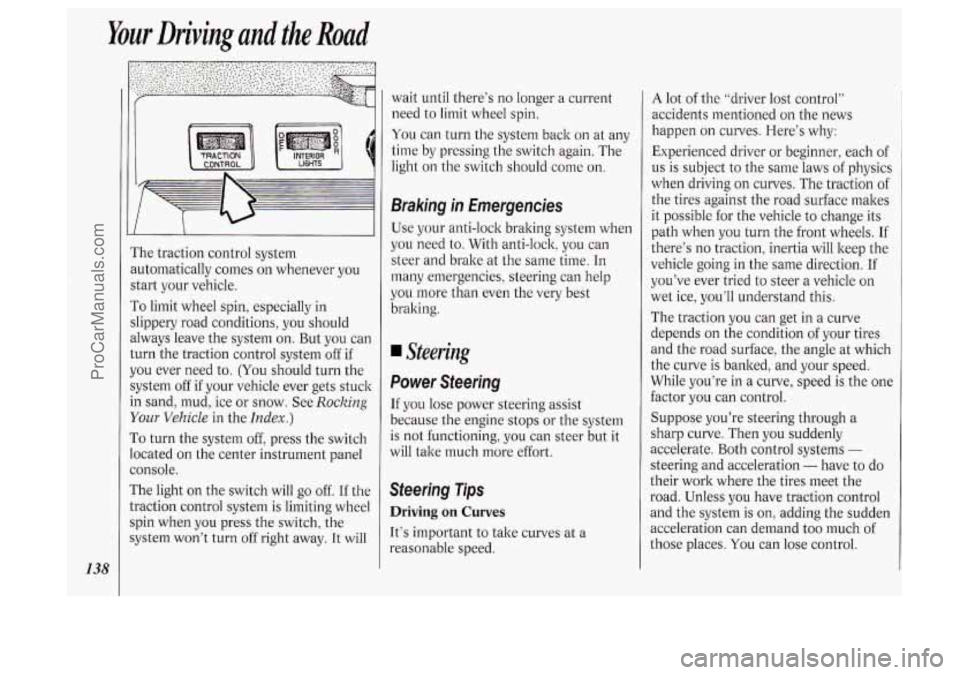
Your Driving and the Road
138
I’he traction control system
mtomatically comes
on whenever you
start your vehicle.
To limit wheel spin, especially in
slippery road conditions, you should
dways leave the system on. But you can
:urn the traction control system off if
IOU ever need to. (You should turn the
;ystem off
if your vehicle ever gets stuck
n sand, mud, ice or snow. See Rocking
Your Vehicle in the Index.)
To turn the system off, press the switch
ocated on the center instrument panel
:onsole.
The light on the switch will go
off. If the
Lraction control system is limiting wheel
;pin when you press the switch, the
;ystem won’t turn
off right away. It will wait until
there’s
no longer a current
need to limit wheel spin.
You can turn the system back on at any
time by pressing the switch again. The
light
on the switch should come on.
Braking in Emergencies
Use your anti-lock braking system when
you need to. With anti-lock, you can
steer and brake at the same time.
In
many emergencies, steering can help
you more than even the very best
braking.
Steering
Power Steering
If you lose power steering assist
because the engine stops or the system
is not functioning, you can steer but it
will take much more effort.
Steering Tips
Driving on Curves
It’s important to take curves at a
reasonable speed.
A lot of the “driver lost control”
accidents mentioned on the news
happen
on curves. Here’s why:
Experienced driver or beginner, each of
us is subject to the same laws of physics
when driving
on curves. The traction of
the tires against the road surface makes
it possible for the vehicle to change its
path when you turn the front wheels. If
there’s
no traction, inertia will keep the
vehicle going in the same direction.
If
you’ve ever tried to steer a vehicle on
wet ice, you’ll understand this.
The traction you can get in a curve
depends
on the condition of your tires
and the road surface, the angle at which
the curve is banked, and your speed.
While you’re in a curve, speed
is the one
factor you can control.
Suppose you’re steering through a
sharp curve. Then you suddenly
accelerate. Both control systems
-
steering and acceleration - have to do
their work where the tires meet the
road. Unless you have traction control
and the system is on, adding the sudden
acceleration can demand too much
of
those places. You can lose control.
ProCarManuals.com